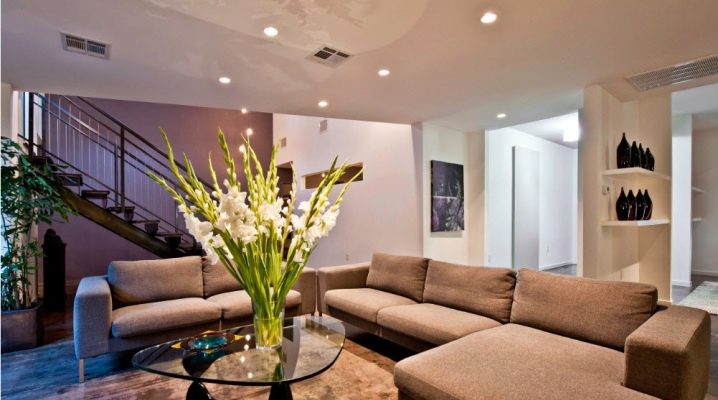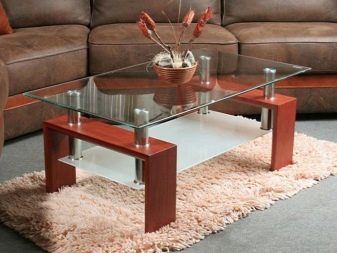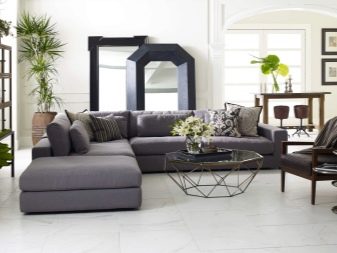Glass coffee tables: elegance in the interior

The modern interior composition resembles the work of a good artist. Everything in it should be thought out right up to the placement of the right accents. One of the must-have accessories for apartment design are coffee tables. They create the right atmosphere, are the final stylistic element, and indicate the design idea. Among the variety of models presented for sale by trade marks, glass coffee tables are especially popular with buyers.


Peculiarities
Glass coffee tables are special furnishings that complement the main seating area. Externally, these are small accessories installed in front of a sofa or armchair, a distinctive feature of which is their compactness and low height. They are not an alternative to dining and written counterparts, they do not provide for a meal or work on a laptop, although in some cases, unknowingly, they are used as tea tables. This is a separate line of furniture that combines functionality and aesthetics.


The main purpose of this accessory is to decorate the interior, making it unique. It is a way of arranging small furnishings that can give the room the desired atmosphere.
This furniture can contain newspapers, magazines, books, fresh flowers, elements of the desired theme that support the style of the interior (shells, graceful figurines, table lamps and other decorative trifles). Often, this furniture stores the necessary little things that should always be at hand (TV remote control, keys, mobile phone).


Advantages and disadvantages
A glass coffee table is a special furniture accessory that has a lot of advantages, it:
- due to the main material of manufacture, it brings lightness and airiness to the interior of the room, without cluttering the usable area;
- it has a wide range of models, so you can choose a product in the same style as the existing furnishings;
- has a rich size range, which allows you to harmoniously fit the accessory into a room of any type (especially important in small rooms);
- maintains the illumination of the room, smoothing out the dark spots of the interior and filling it with light;


- with the right approach to the choice, it looks harmoniously in any interior style (playing with the texture of the material and creating the necessary decorating techniques);
- it is distinguished by its robust construction: it is made of reliable and dense glass, resistant to accidental mechanical stress;
- is a practical accessory, distinguished by durability of operation, excellent appearance, ease of maintenance;
- depending on the model, it has a variability of shape, which makes it possible for the buyer to choose a product, taking into account the peculiarities of the existing furniture;


- it looks impressive, regardless of the model: this furniture is always unique and attracts attention, thereby allowing it to be distracted from the impenetrable corners of the room;
- environmentally friendly and hypoallergenic furniture, not inferior to analogues made of wood: during operation it does not emit harmful substances into the air, is not subject to destruction, excludes the formation of microorganisms and mold;
- perfectly complements the interior composition of different rooms (bedroom, living room), zoning the room if necessary;
- depending on the density, the amount of material, the composition of the finish, it differs in price, allowing the buyer to choose the best option, taking into account taste preferences and the planned budget.


Glass tables are not subject to temperature extremes, they are resistant to moisture, so they can decorate the interior of any home, including rooms with high humidity. These models differ from their bedside counterparts in shape: they are somewhat wider, lower, and have a large countertop area. Often, models are mobile and have wheels: this way you can move them closer to the sofa, move them away if they interfere, put them in the corner of the room if you urgently need to free up space.
Due to the use of dyes, models can have different colors, which makes their appearance premium and hints at the well-being of the owners of the house. In addition, the surface can be embossed, colored or printed.


While the glass coffee table is replete with merits, it does have drawbacks.
This piece of furniture:
- brings cold notes to the interior, therefore, requires a thorough choice of shades of furnishings, including wall cladding, the color of the flooring, furniture, curtains, lamps;
- with significant mechanical damage, it can break, form scratches or cracks, therefore, it needs careful use;
- needs perfect cleanliness: water stains, fingerprints, dust are perfectly visible on the transparent surface;
- complemented by different finishes, dust and small particles of litter accumulate at the joints, which cannot always be removed.


A glass coffee table obliges you to a certain status of the furnishings: furniture, textiles, wall decoration, small interior decor will be compared with it, so they must match the accessory. In addition, these tables need a repetition of the material used: if they are made exclusively of glass, it should also be used in a ceiling or wall light source. Choosing a model with metal or wood trim, the decor in the interior should be repeated (at least in shade, maximum in texture). Otherwise, the accessory will look in isolation, breaking the atmosphere into separate scattered elements.

Varieties
Glass coffee tables - a huge world of models. They can be conditionally divided into three groups:
- monolithic;
- sliding;
- folding.



Each design has a variety of forms, its own set of decorative techniques, combination with other raw materials. Monolithic varieties are mostly decorative tables, mainly with a solid matte or transparent top. The material is hardened, which increases its strength.
Frosted glass is a tricky design technique: so fingerprints are less noticeable on the surface. These accessories are comfortable, and due to the shade they gently diffuse light.

The possibility of transformation makes the product more functional. Sliding structures are distinguished by a synchronous mechanism, while the area of the tabletop of the accessory can be doubled or even quadrupled. It is not uncommon for a model to change shape during transformation.
Folding counterparts are not inferior to the previous varieties in a wide range. Their distinguishing feature from the sliding elements is the fact that in the first case the countertop area is increased by folding it out, in the second - by adding additional parts.
Due to the thoughtfulness of ergonomics, the transformation allows you to create a unique and stylish option, which can be symmetrical or design - with asymmetry.


Each line contains classic, standard and designer luxury products that can be on:
- one leg;
- three or four supports;
- one round support or two crossed ones;
- wheels;
- glass side faces.



Dimensions (edit)
The dimensions of modern glass coffee tables do not have strict standards. Today, the parameters are set by manufacturers, so each brand adheres to its own dimensions.
In general, the models can be divided into:
- small;
- moderate to medium;
- spacious.
In this case, the smaller varieties are folding: the tabletop can be 40x40, 50x50 cm, have a height of 35-45 cm. Some products are up to 1 meter in length. Transformers reach a length of 130 cm, having a width of 65-70 cm.


Forms
Glass coffee tables attract attention with a unique form, which is complemented by decorative techniques.
The most popular products:
- Round and triangular shapes with an accent on the base and additions in the form of decorative elements, small shelves or without them;
- Rectangular models - a classic with the usual supports and the presence of additional shelves under the table top;
- Tables in the form of a square or a cube - models for the most part without shelves with an original design of the supports;


- Oval varieties - options for a one- and two-story plan with an unusual lower stand for small things;
- Curly options - unusual shapes with a functional base (curved glass, crossed parts, curly edge);
- Abstraction is a kind of creative, tuned in to aesthetic perception, therefore, it often does not have a functional load.


Materials (edit)
The uniqueness of the material lies in its combination with different raw materials. Glass goes well with metal, rattan, wood, maple, chrome, plastic finishes. At the same time, the surface of the glass and the finish can be different (matte, glossy, smooth, embossed, carved).
The most successful combination options are chrome and solid wood. Products created with this finish or body stand out against the backdrop of upholstered furniture.
They are distinguished by solidity, however, if models with wood look massive, analogs with forged decor made of bent metal are able to stretch any setting, endowing it with lightness.


Lacobel (tinted glass) with a uniform color, reinforced glass or triplex is used in production. The most favorite technique is the lacobel: monochromatic designs or models with a print stand out against the background of any furniture. More often, the design provides for two shades, with the help of which one of the tones of monochromatic products is distinguished or accentuates the pattern of the table top.
Prints are varied: these are strict lines, carved motifs, floral sketches, geometry and images of the sun.


Colors
Thanks to modern technology, the color of the glass tables is varied. In addition to the classics (transparent and white), opaque brown and black tones are fashionable and stylish shades of the models. Combining with the light tone of metal or wood, the dark side of the table creates a special atmosphere.
Transparent options with a color additive (blue, grayish, turquoise) are original, but require shade support in furnishings.

An excellent and fashionable technique is the finish in light or dark wenge color: glass models with a wood case in this tone perfectly fit into any classic and modern direction. Today they are in the spotlight.
At the same time, it does not matter at all whether the model is made with a partition, supports, shelves or other additions: the shade speaks of the special status of the table, even if the tabletop is laconic and does not have a curly shape.

In various styles
A masterful approach to the design of the interior composition allows you to fit glass coffee tables in different styles. Of course, they are not suitable for rough designs in the spirit of a loft, even if they deliberately shout with minimalistic design and simplicity of form. It is undesirable to use them in the country style: status furniture is an order of magnitude higher than the rustic theme. Glass is appropriate for modern and classic design techniques.
Such accessories look most harmoniously in the direction:
- modern;
- classic;
- minimalism;
- high tech;
- avant-garde;


- Art Deco;
- bauhaus;
- bionics;
- constructivism;
- contemporary.
The basis for a successful infusion into the desired style is due to the presence of taste: sometimes you can combine the incongruous, while it looks like it will be an inseparable part of the whole environment.


Which table to choose?
When choosing a model, you cannot copy a certain style. Of course, the product should be liked, however, everyone's habits and tastes are different. What is good for one user seems uncomfortable to another.
The choice is based on several factors:
- If you need a functional model, you should pay attention to the folding option: it is convenient, adapts to a specific case, is simple in appearance, while not devoid of a premium look and harmoniously fits into most stylistic design directions.
- If there is no long-pile carpet in the location of the table, it is worth choosing a model on wheels: it is mobile, its location can be adjusted, while the legs will not scratch the surface of the floor covering.
- If there is a carpet, it makes sense to pay attention to a product with massive legs with a smoothed shape: they will not create pronounced dents on the surface of the carpet and will not spoil its structure if the table has to be moved (they will not hook or tear the pile).



- When choosing a model made of glass for the living room, it is important to think about practicality: it is preferable to purchase a model with a metal or wood case and reliable legs (with regular cleaning of the floor, the supports will not lose their attractive appearance).
- If you need an exclusive version of the accessory, when ordering, you should pay attention to the inadmissibility of sharp decorative elements that can injure the user or cause the surface to chip.
- If leaving is not a problem, you should take a closer look at the model with a top stop: objects located on a tabletop with a piping made of a different material will not fall to the floor, even if the floor in the room is not completely flat (especially important if the table is located on the carpet).


- With regards to the design, everything is individual, although the more complex the product, the greater the likelihood of a breakdown of the mechanism (it is better to rely on a stylish look and reliability than a massive and complex technical design).
- The size of the tabletop and the height of the table depend on the characteristics of the room and the parameters of the furniture: it should be convenient to get the desired item from the sofa, the surface area should be sufficient, otherwise the table looks like a chair that has fallen out of the furniture ensemble.
- Color matters: through the shade, you can beat the lack of lighting in the room, or, conversely, emphasize with its help the light colors of the interior.


Checking the model is carried out empirically: by placing a weighty object on the tabletop, you can assess the stability of the structure and the ability to move (for models with wheels). In addition to the basic rules, the build quality, the availability of a quality certificate and a product passport are important.
It makes no sense to buy on the Internet: there is a great risk of acquiring a low-quality fake.

Interior options
Glass coffee tables are a great interior solution. To appreciate their beauty, you can see examples of locations suggested by experienced designers:
- The model with a glass top, wooden body and carved legs, made in black, will harmoniously complete the ensemble of upholstered furniture in milky tones, supported by decorative pillows to match the table.

- A laconic rectangular model, framed in a metal case, is appropriate in the interior of a home library: to accentuate it, fresh flowers and a small monochrome rug are enough.

- A round glass table on four metal legs will fit into the interior of the living room, made in beige and gray colors: to support the product, you can use a jug of flowers, a bowl of fruit and several books.

- You can highlight the recreation area with an oval-shaped model with two floors, placing bright furnishing accessories on the tabletop, and below unusual gizmos in the same tone as the color of decorative pillows: simple and stylish.

You can make a glass coffee table with your own hands. How to do this, see the next video.













The comment was sent successfully.